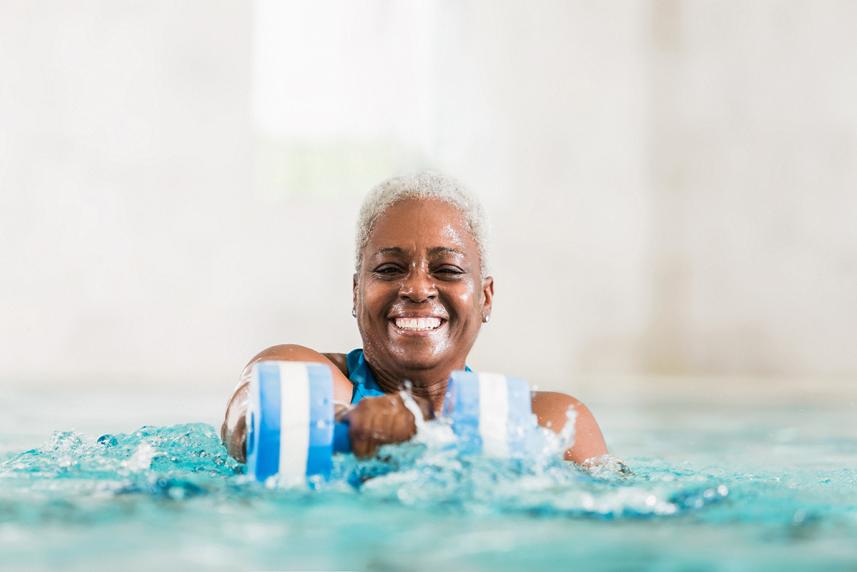
Stock up on your health care essentials at Optum Store. Use your HSA/FSA dollars to save even more.

Build strength and take pressure off your joints. Here's how to use water to find your strongest and leanest self.
You know those hot summer days when all you want to do is jump in some nice cool water? Well, here’s another good reason to take that plunge: Water is one of the best places to get a great workout. It’s easy on your joints (low impact). And it helps build strength because it provides natural resistance as you move. Those qualities make it a great choice for any age and ability level.
Water workouts offer many of the same benefits as exercise on dry land. They may strengthen your heart, build muscle and improve your ability to move. Both can also lift your mood instantly and wash away stress.
But if you’re dealing with an injury, aches and pains, or haven’t worked out recently, you might want to trade your shorts and sneakers for a swimsuit. “The benefits of water workouts run deep,” says Ben Brock. He’s a certified strength and conditioning specialist and the director of community programs at OptumCare® Arizona.
Here are a few reasons you should take advantage of this low-risk, high-reward exercise. Plus, we have plenty of ideas on how to make the most of your water time.
Get more tips you can trust delivered straight to your inbox. Sign up for our newsletter today.
If you’ve ever floated on your back in a pool or lake, you know the weightless feeling that water can bring. And it’s not just in your head. Being in the water can significantly reduce the amount of weight your joints bear.1
This can make it easier to boost your fitness without straining your body. “It’s a low-impact environment,” says Bethany Gray, DO. She’s the medical director at Optum in Irvine, California. “It’s a really good way to take some of the pressure off of some of your joints.”
Do your knees ache when you try to run or walk? What about your shoulders when you hit the tennis court or golf range?
A water workout can be an excellent choice for people dealing with joint pain, back pain and knee or hip injuries, says Brock. It lets you build muscle and work on your movement without aggravating your injury or pain, according to the Centers for Disease Control and Prevention.2

Stock up on your health care essentials at Optum Store. Use your HSA/FSA dollars to save even more.
“People are able to go through a bigger range of motion than they would be able to on land just because a lot of that extra load goes away,” adds Brock. And the bigger the range of motion you move through, the more it lubricates your joints, which makes them work and feel better.
Moving your arm through the water is much more challenging than moving through the air. This is because water offers natural resistance, which helps build muscle strength and endurance.
“It requires more force to your arms and legs through their range of motion,” says Brock. The muscles must tighten more to help you move. This, in turn, improves strength.
You can even change how difficult your workout is simply by changing the speed of your movements. For example, pumping your arms as fast as you can underwater creates something called drag. That means it makes the movement harder, also building more strength and endurance, Brock explains. The slower you go, the easier the movements will be.
There’s no “right” way to exercise in the water. You can do everything from strength to cardio to mobility work in the pool (or lake, river or ocean). Plus, it’s good for all people, no matter where they are in their fitness journey. “It’s really quickly, easily adaptable for a variety of ability levels,” says Brock.
Say you’re feeling sore, but you still want to work out. Hop in the pool for a cardio session instead of a run. Or maybe you’re managing joint pain and can’t bear the thought of taking a walk. Water is the perfect place for you to get your heart pumping.
(Ready to level up your routine? Try our two-week fitness challenge.)
You have many options when it comes to water workouts. For a well-rounded water session, Brock recommends picking your preferred way to work out or mixing and matching from any of the exercises below:
Swim laps. Keep track of how many you can do without taking a break. Then try to add one to that number each week.
Walk or run. You can stay at the shallow end or push yourself to move around. Many pools also have flotation belts available for extra support. They wrap around your waist so you’re able to move your arms and legs freely.
Try a water aerobics class. If one isn’t available in your area, you may find videos online to inspire you and get some workout guidance. Or Brock suggests creating your own class. Put on your favorite music and do any movement over and over that uses your major muscles. Some ideas to steal from land aerobics: jumping jacks, marching with high knees, arm circles, and stepping side to side.
Challenge your strength. Many dry-land strength moves such as biceps curls and chest presses can also be done in the water. Use the natural force of the water to add resistance as you go through the exercise. And remember to play with your speed. You can also up your game by using webbed gloves or water weights.
Stretch it out. Who said water workouts have to be super strenuous? Take advantage of the water’s buoyancy to do your favorite stretches and balance exercises. This can be as simple as standing on one foot or moving your joints. Think: hip and ankle circles, knee bends and shoulder raises.
If you don’t have a pool in your backyard, check out the offerings in your city or town. Many areas have low-cost community pools or fitness centers you can use. That said, don’t rule out other bodies of water, such as lakes, calm rivers or oceans. Just make sure to be safe. Go with a friend or tell someone your plan for the day, and wear flotation devices when necessary. And don’t forget the sunscreen.
Stock up on all your health essentials in one swoop at the Optum Store. From pain medication and fitness trackers to sunscreen and vitamins, we have you covered. Shop now.
Sources
© 2024 Optum, Inc. All rights reserved. Do not reproduce, transmit or modify any information or content on this website in any form or by any means without the express written permission of Optum.
The information featured in this site is general in nature. The site provides health information designed to complement your personal health management. It does not provide medical advice or health services and is not meant to replace professional advice or imply coverage of specific clinical services or products. The inclusion of links to other websites does not imply any endorsement of the material on such websites.
Consult your doctor prior to beginning an exercise program or making changes to your lifestyle or health care routine.
Stock photo. Posed by model.